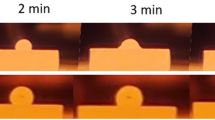Abstract
Braze joints have been formed between Ag/W electrical contact tips and Sn-coated Cu straps using a Cu–Ag–P-based filler metal by short-cycle direct conductive heating from the Cu strap side. The microstructures of the braze joints have been investigated using a combination of scanning electron microscopy, energy-dispersive X-ray spectroscopy, electron backscatter diffraction, focused ion beam milling, and transmission electron microscopy. The braze joints exhibit regions with two distinct types of microstructures. Type I microstructures contain three micro-constituents: FCC (Ag), FCC (Cu), and a ternary eutectic [(Ag) + (Cu) + Cu3P]. The difference between the proportions of these phases and those in the baseline filler metal can be accounted for on the basis of P loss due to self-fluxing during the brazing process. Type II microstructures contain mostly (Ag) and (Cu) with a small amount of Cu3P but no ternary eutectic mixture. Other differences from the Type I regions include a lower P content, incomplete dispersion of the Sn layer, and a refined grain size in the majority (Cu) phase. These effects are accounted for on the basis of local differences in interfacial pressure due to the geometry of the Ag/W contact surface.







Similar content being viewed by others
Notes
Following Takemoto et al. [8] we designate the Cu- and Ag-rich face-centered-cubic (FCC) solid solutions in this system as (Cu) and (Ag), respectively.
References
Schwartz MM (2003) Brazing, 2nd edn. ASM International, Metals Park
Jacobson DM, Humpston G (2005) Principles of brazing. ASM International, Metals Park
Dawson RJC (1973) Fusion welding and brazing of copper and copper alloys. Wiley, New York
Davis JR (2001) Brazing, soldering and adhesive bonding. In: Davis JR (ed) Copper and copper alloys. ASM International, Metals Park, pp 303–318
Okamoto H (2000) Phase diagrams for binary alloys, Desk Handbook. ASM International, Metals Park
Moser H, Fröhlich KW, Raub E (1932) Das dreistoffsystem Silber-Kupfer-Phosphor. Z Anorg Allg Chem 208:225–237 (in German)
Kubaschewski O (1988) Silver-copper-phosphorus. Ternary alloys, vol 1. VCH, New York, pp 609–612
Takemoto T, Okamoto I, Matsumura J (1987) Phase diagrams of Cu–Ag–P and Cu–Sn–P ternary brazing filler metals. Trans JWRI 16:73–79
Olofsson O (1972) The crystal structure of Cu3P. Acta Chem Scand 26:2777–2787
Karamis MB, Tasdemirci A, Nair F (2003) Microstructural analysis and discontinuities in the brazed zone of copper tubes. J Mater Proc Tech 141:302–312
Weigert KM (1956) Physical properties of commercial silver-copper-phosphorus brazing alloys. Weld J 67:672–674
Lyubov BY (1978) Kinetic theory of phase transformations. Amerind Publishing Co., New Delhi (translated from the Russian)
Larche FC, Cahn JW (1984) The interactions of composition and stress in crystalline solids. J Res Nat Bur Stand 89:467–500
Xuan F, Shao S, Wang Z, Tu S (2009) Coupling effects of chemical stresses and external mechanical stresses on diffusion. J Phys D Appl Phys 42:015401
Hong SQ, Hong QZ, Mayer JW (1993) Effects of grown-in stress on the metastable solid solubility limits in Sb-implanted Ge0.1Si0.9 alloys. Appl Phys Lett 63:2053–2055
Ozaki Y, Saito S (1971) Pressure effects on the eutectic temperature of the Sn–Zn, Sn–Pb, Sn–Bi and Cd–Zn systems. Jpn J Appl Phys 10:149–153
Ryzhenko B, Kennedy GC (1973) The effect of pressure on the eutectic in the system Fe–FeS. Am J Sci 273:803–810
Acknowledgements
This work was supported by a research grant from GE Industrial Solutions under a GE-UConn partnership agreement, and by the award of a GE Graduate Fellowship to Haibo Yu. The authors would like to thank Jonathan Potter and Jason Harmon from GE for helpful discussions, and Dr. Richard McLaughlin of Oxford Instruments for assistance with the EBSD experiments.
Author information
Authors and Affiliations
Corresponding author
Rights and permissions
About this article
Cite this article
Yu, H., Sun, Y., Alpay, S.P. et al. Microstructure effects in braze joints formed between Ag/W electrical contacts and Sn-coated Cu using Cu–Ag–P filler metal. J Mater Sci 50, 324–333 (2015). https://doi.org/10.1007/s10853-014-8591-7
Received:
Accepted:
Published:
Issue Date:
DOI: https://doi.org/10.1007/s10853-014-8591-7




